Evolution of Deep-Seated Gravitational Slope Deformations in Relation with Uplift and Fluvial Capture Processes in Central Eastern Sardinia (Italy)
Abstract
:1. Introduction
2. Geological Setting
3. Geodynamic Setting
4. Geomorphological Setting
- The first stage preceding the capture of the Rio Pardu by the Rio Pelau associated with the uplift and the Plio-Quaternary tectonics. This phase involves a general incision of the valleys and erosion of the slopes, and it led to a new hydrographic setting, causing river capture (Middle-Lower Pleistocene).
- The second phase was associated with major erosive activity in the Pardu Valley following the capture, which led to complete erosion of the valley (Upper Pleistocene).
- The present evolution of the slopes through widespread landslides and DGSDs.
5. Materials and Methods
5.1. Aerial and Uncrewed Aerial Vehicle Remote Sensing
5.2. InSAR Analysis
6. Results
6.1. InSAR, PS, and Time Series Analysis
6.2. Deep-Seated Gravitational Slope Deformation
6.3. River Capture Analysis
- An erosive increase caused by a generalized uplift that led to the retreat towards the inland by the head of the Rio Pelau until it connected with the Rio Pardu.
- Another hypothesis foresees the presence of a direct fault with an east–west course along which the Rio Pelau is set. In this case, the differential uplift of the block on which the Rio Quirra is currently set could justify the capture process as tectonogenic.
6.4. Fluvial Morphostratigraphic Analysis
7. Discussion
7.1. River Analysis
7.2. DGSD Dynamics
8. Conclusions
- The geomorphological and structural setting of Ogliastra is closely linked to the genesis of the east Sardinian continental margin due the opening of the Tyrrhenian basin (Miocene–Pliocene)
- Distensive Pliocene tectonics accompanied by widespread volcanism resulted in a general uplift in Sardinia. The Quaternary uplift rebound manifested itself with an important erosive phase and variations in the hydrographic network. We have evidence of this phase in the Rio Quirra Valley, which is represented by paleo-DGSDs fossilized by pre-Tyrrhenian alluvial deposits (Lower Pleistocene).
- The river capture of Rio Pardu is associated with this important erosive phase and caused an erosive increase that led to a complete emptying of the valley (Upper-Middle Pleistocene).
- The post-capture decompression of the slopes of the Rio Pardu triggered DGSDs in both flanks in the current state of activity.
- Using InSAR data, it was possible to identify and assign displacement rates to the Ulassai, Osini, and Gairo DGSDs.
Author Contributions
Funding
Institutional Review Board Statement
Informed Consent Statement
Data Availability Statement
Acknowledgments
Conflicts of Interest
References
- Carmignani, L.; Oggiano, G.; Barca, S.; Conti, P.; Salvadori, I.; Eltrudis, A.; Funedda, A.; Pasci, S. Geologia della Sardegna: Note Illustrative della Carta Geologica della Sardegna in scala 1:200.000. In Memorie Descrittive della Carta Geologica d’Italia; ISPRA—Servizio Geologico d’Italia: Rome, Italy, 2001; Volume 60. [Google Scholar]
- Carminati, E.; Doglioni, C. Mediterranean tectonics. In Encyclopedia of Geology; Selley, R., Cocks, R., Plimer, I., Eds.; Elsevier: Amsterdam, The Netherlands, 2005; pp. 135–146. [Google Scholar]
- Cherchi, A.; Montadert, L. Oligo-Miocene rift of Sardinia and the early history of the Western Mediterranean Basin. Nature 1982, 298, 736–739. [Google Scholar] [CrossRef]
- Maxia, C.; Ulzega, A.; Marini, C. Studio idrogeologico dei dissesti nel bacino del Rio Pardu (Sardegna centro-orientale). Pubblicazione dell’Istituto di Geologia, Paleontologia e Geografia Fisica 1973, 12, 1–9. [Google Scholar]
- Ulzega, A.; Marini, A. L’évolution des versants dans la vallée du Rio Pardu (Sardaigne centre-orientale). Zeitschrift fur Geomorphologie 1973, 21, 466–474. [Google Scholar]
- Demurtas., V.; Orrù, P.E.; Deiana, G. Deep-seated gravitational slope deformations in central Sardinia: Insights into the geomorphological evolution. J. Maps 2021, 17, 594–607. [Google Scholar]
- De Waele, J.; Ferrarese, F.; Granger, D.; Sauro, F. Landscape evolution in the Tacchi area (central-east Sardinia, Italy) based on karst and fluvial morphology and age of cave sediments. Geografia Fisica e Dinamica Quaternaria 2012, 35, 119–127. [Google Scholar] [CrossRef]
- Deiana, G.; Lecca, L.; Melis, R.T.; Soldati, M.; Demurtas, V.; Orrù, P.E. Submarine geomorphology of the southwestern Sardinian continental shelf (Mediterranean Sea): Insights into the last glacial maximum sea-level changes and related environments. Water 2021, 13, 155. [Google Scholar] [CrossRef]
- Suhail, H.A.; Yang, R.; Chen, H.; Rao, G. The impact of river capture on the landscape development of the Dadu River drainage basin, eastern Tibetan plateau. J. Asian Earth Sci. 2020, 198, 1367–9120. [Google Scholar] [CrossRef]
- Carabella, C.; Buccolini, M.; Galli, L.; Miccadei, E.; Paglia, G.; Piacentini, T. Geomorphological analysis of drainage changes in the NE Apennines piedmont area: The case of the middle Tavo River bend (Abruzzo, central Italy). J. Maps 2020, 16, 222–235. [Google Scholar] [CrossRef] [Green Version]
- Fan, N.; Chu, Z.; Jiang, L. Abrupt drainage basin reorganization following a Pleistocene river capture. Nat. Commun. 2018, 9, 3756. [Google Scholar] [CrossRef] [Green Version]
- Bishop, P. Drainage rearrangement by river capture, beheading and diversion. Prog. Phys. Geogr. 1995, 19, 449–473. [Google Scholar] [CrossRef]
- Willett, S.D.; McCoy, S.W.; Perron, J.T.; Goren, L.; Chen, C.Y. Dynamic reorganization of river basins. Science 2014, 343, 1117. [Google Scholar]
- Whipple, K.X.; Forte, A.M.; Di Biase, R.A. Timescales of landscape response to divide migration and drainage capture: Implications for the role of divide mobility in landscape evolution. J. Geophys. Res. Earth Surf. 2017, 122, 248–273. [Google Scholar]
- Prince, P.S.; Spotila, J.A.; Henika, W.S. Stream capture as driver of transient landscape evolution in a tectonically quiescent setting. Geology 2011, 39, 823–826. [Google Scholar]
- Aslan, A.; Hood, W.C.; Karlstrom, K.E.; Kirby, E.; Granger, D.E.; Kelley, S.; Asmerom, Y. Abandonment of Unaweep Canyon (1.4–0.8 Ma), western Colorado: Effects of stream capture and anomalously rapid Pleistocene river incision. Geosphere 2014, 10, 428–446. [Google Scholar] [CrossRef] [Green Version]
- Shugar, D.; Clague, J.; Best, J.; Schoof, C.; Willis, M.; Copland, L.; Roe, G. River piracy and drainage basin reorganization led by climate-driven glacier retreat. Nat. Geosci. 2017, 10, 370–375. [Google Scholar] [CrossRef]
- Bracciali, L.; Najman, Y.; Parrish, R.R.; Akhter, S.H.; Millar, I. The Brahmaputra tale of tectonics and erosion: Early Miocene river capture in the Eastern Himalaya. Earth Planet. Sci. Lett. 2015, 415, 25–37. [Google Scholar] [CrossRef] [Green Version]
- Antón, L.; De Vicente, G.; Munoz-Martin, A.; Stokes, M. Using river long profiles and geomorphic indices to evaluate the geomorphological signature of continental scale drainage capture, Duero basin (NW Iberia). Geomorphology 2014, 206, 250–261. [Google Scholar] [CrossRef]
- Pánek, T.; Šilhán, K.; Tábořík, P.; Hradecký, J.; Smolková, V.; Lenart, J.; Pazdur, A. Catastrophic slope failure and its origins: Case of the May 2010 Girová Mountain long-runout rockslide (Czech Republic). Geomorphology 2011, 130, 352–364. [Google Scholar] [CrossRef]
- Quesada-Román, A.; Fallas-López, B.; Hernández-Espinoza, K.; Stoffel, M.; Ballesteros-Cánovas, J.A. Relationships between earthquakes, hurricanes, and landslides in Costa Rica. Landslides 2019, 16, 1539–1550. [Google Scholar] [CrossRef]
- Volpe, E.; Ciabatta, L.; Salciarini, D.; Camici, S.; Cattoni, E.; Brocca, L. The impact of probability density functions assessment on model performance for slope stability analysis. Geosciences 2021, 11, 322. [Google Scholar]
- Shou, K.J.; Chen, J. On the rainfall induced deep-seated and shallow landslide hazard in Taiwan. Eng. Geol. 2021, 288, 106156. [Google Scholar] [CrossRef]
- Quesada-Román, A. Landslide risk index map at the municipal scale for Costa Rica. Int. J. Disaster Risk Reduct. 2021, 56, 102144. [Google Scholar] [CrossRef]
- Marini, A.; Ulzega, A. Osservazioni geomorfologiche sul tacco di ulassai. Rendiconti Seminario Facoltà Scienze Università di Cagliari 1977, 47, 192–208. [Google Scholar]
- Proggetto AVI Aree Vulnerate Italiane. Available online: http://avi.gndci.cnr.it/ (accessed on 1 September 2020).
- Moretti, A. Sui movimenti franosi degli abitati di Osini e di Gairo (Nuoro). Bollettino del Servizio Geologico d’Italia 1953, 75, 2. [Google Scholar]
- Zischinsky, U. On the deformation of high slopes. In Proceedings of the 1st Conference International Society for RockMechanics, Lisbon, Portugal, 25 September–1 October 1966; Volume 2, pp. 179–185. [Google Scholar]
- Zischinsky, U. Über Sackungen. Rock Mech. 1969, 1, 30–52. [Google Scholar] [CrossRef]
- Radbruch-Hall, D.; Varnes, D.J.; Savage, W.Z. Gravitational spreading of steep-sided ridges (“sackung”) in western United States. Bull. Int. Assoc. Eng. Geol. 1976, 13, 23–35. [Google Scholar] [CrossRef]
- Radbruch-Hall, D. Gravitational creep of rock masses on slopes. In Rockslides and Avalanches—Natural Phenomena: Developments in Geotechnical Engineering; Voight, B., Ed.; Elsevier: Amsterdam, The Netherlands, 1978; Volume 14, pp. 607–658. [Google Scholar]
- Bisci, C.; Dramis, F.; Sorriso-Valvo, M. Rock flow (sackung). In Landslide Recognition: Identification, Movement and Causes; Dikau, R., Brunsden, D., Schrott, L., Ibsen, M.L., Eds.; John Wiley & Sons, Inc.: Hoboken, NJ, USA, 1996; pp. 150–160. [Google Scholar]
- Jahn, A. Slope morphological feature resulting from gravitation. Z. Für Geomorphol. 1964, 5, 59–72. [Google Scholar]
- Cruden, D.M.; Varnes, D.J. Landslide Types and Processes. Spec. Rep. Natl. Res. Counc. Transp. Res. Board 1996, 247, 36–75. [Google Scholar]
- Pasuto, A.; Soldati, M. Lateral spreading. In Landslide Recognition: Identification, Movement and Causes; Dikau, R., Brunsden, D., Schrott, L., Ibsen, M.-L., Eds.; John Wiley & Sons, Inc.: Hoboken, NJ, USA, 1996; pp. 122–136. [Google Scholar]
- Dramis, F.; Sorriso-Valvo, M. Deep-seated gravitational slope deformations, related landslides and tectonics. Eng. Geol. 1994, 38, 231–243. [Google Scholar] [CrossRef]
- Dramis, F.; Farabollini, P.; Gentili, B.; Pambianchi, G. Neotectonics and large scale gravitational phenomena in the Umbria –Marche Apennines, Italy. In Seismically Induced Ground Ruptures and Large Scale Mass Movements, Field Excursion and Meeting; Comerci, V., D’Agostino, N., Fubelli, G., Molin, P., Piacentini, T., Eds.; APAT: Rome, Italy, 2002; Volume 21, pp. 17–30. [Google Scholar]
- Agliardi, F.; Scuderi, M.M.; Fusi, N.; Cristiano, C. Slow-to-fast transition of giant creeping rockslides modulated by undrained loading in basal shear zones. Nat. Commun. 2020, 11, 1352. [Google Scholar] [CrossRef]
- Crosta, G.B.; Agliardi, F. Failure forescast for large rock slides by surface displacement measurements. Can. Geotech. J. 2003, 40, 176–191. [Google Scholar] [CrossRef]
- Nemčok, A. Gravitational slope deformation in high mountains. In Proceedings of the 24th International Geology Congress, Montreal, QC, Canada, 1972; Volume 13, pp. 132–141. [Google Scholar]
- Ostermann, M.; Sanders, D. The Benner pass rock avalanche cluster suggests a close relation between long-term slope deformation (DSGSDs and translational rock slides) and catastrophic failure. Geomorphology 2017, 289, 44–59. [Google Scholar] [CrossRef]
- Soldati, M. Deep-seated gravitational slope deformation. In Encyclopedia of Natural Hazards; Bobrowsky, P.T., Ed.; Encyclopedia of Earth Sciences Series; Springer: Berlin/Heidelberg, Germany, 2013. [Google Scholar]
- Agliardi, F.; Crosta, G.; Zanchi, A. Structural constraints on deep seated slope deformation kinematics. Eng. Geol. 2001, 59, 83–102. [Google Scholar] [CrossRef]
- Chigira, M. Long-term gravitational deformation of rocks by mass rock creep. Eng. Geol. 1992, 32, 157–184. [Google Scholar] [CrossRef]
- Crosta, G.B.; Frattini, P.; Agliardi, F. Deep seated gravitational slope deformations in the European Alps. Tectonophysics 2013, 605, 13–33. [Google Scholar] [CrossRef]
- Mariani, G.S.; Zerboni, A. Surface geomorphological features of deep-seated gravitational slope deformations: A look to the role of lithostructure (N Apennines, Italy). Geosciences 2020, 10, 334. [Google Scholar] [CrossRef]
- Pánek, T.; Klimeš, J. Temporal behavior of deep-seated gravitational slope deformations: A review. Earth-Sci. Rev. 2016, 156, 14–38. [Google Scholar] [CrossRef]
- Crosta, G.B.; Zanchi, A. Deep-seated slope deformations. Huge, extraordinary, enigmatic phenomena. In Landslides in Research, Theory and Practice; Bromhead, E., Dixon, N., Ibsen, M., Eds.; Thomas Telford Ltd.: London, UK, 2000; pp. 351–358. [Google Scholar]
- Gentili, B.; Pambianchi, G. Gravitational morphogenesis of the Apennine chain in Central Italy. In Proceedings of the 7th International Congress International Association of Engineering Geology, Lisboa, Portugal, 5–9 September 1994; Volume 3, pp. 1177–1186. [Google Scholar]
- Iovine, G.; Tansi, C. Gravity-accommodated ‘structural wedges’ along thrust ramps: A kinematic scheme of gravitational evolu-tion. Nat. Hazards 1998, 17, 195–224. [Google Scholar] [CrossRef]
- Frigerio, S.; Schenato, L.; Bossi, G.; Cavalli, M.; Mantovani, M.; Marcato, G.; Pasuto, A. A web-based platform for automatic and continuous landslide monitoring: The Rotolon (Eastern Italian Alps) case study. Comput. Geosci. 2014, 63, 96–105. [Google Scholar]
- Sestras, P.; Bilașco, Ș.; Roșca, S.; Dudic, B.; Hysa, A.; Spalević, V. Geodetic and UAV monitoring in the sustainable management of shallow landslides and erosion of a susceptible urban environment. Remote Sens. 2021, 13, 385. [Google Scholar]
- Zhang, L.; Wang, X.; Xia, T.; Yang, B.; Yu, B. Deformation characteristics of Tianjiaba landslide induced by surcharge. ISPRS Int. J. Geo-Inf. 2021, 10, 221. [Google Scholar] [CrossRef]
- Bianchini, S.; Solari, L.; Bertolo, D.; Thuegaz, P.; Catani, F. Integration of satellite interferometric data in civil protection strategies for landslide studies at a regional scale. Remote Sens. 2021, 13, 1881. [Google Scholar] [CrossRef]
- Demurtas, V.; Orrù, P.; Deiana, G. Multi-source and multi-scale monitoring system of deep-seated gravitational slope deformation in east-central sardinia. Planet Care Space 2021, 2, 28–32. [Google Scholar] [CrossRef]
- Carmignani, L.; Oggiano, G.; Funedda, A.; Conti, P.; Pasci, S. The geological map of Sardinia (Italy) at 1:250,000 scale. J. Maps 2016, 12, 826–835. [Google Scholar] [CrossRef]
- Pertusati, P.C.; Sarria, E.; Cherchi, G.P.; Carmignani, L.; Barca, S.; Benedetti, M.; Chighine, G.; Cincotti, E.; Oggiano, G.; Ulzega, A.; et al. Geological Map of Italty. Scale 1:50.000; Scheet 541 “Jerzu”; ISPRA-Servizio Geologico Nazionale: Rome, Italy, 2002. [Google Scholar]
- Chiocci, F.L.; Budillon, F.; Ceramicola, S.; Gamberi, F.; Orrù, P. A Tlante dei Lineamenti di Pericolosità Geologica dei Mari Italiani-Risultati del Progetto MaGIC; CNR Edizioni: Rome, Italy, 2021. [Google Scholar]
- Carmignani, L.; Carosi, R.; Di Pisa, A.; Gattiglio, G.; Musumeci, G.; Oggiano, G.; Pertusati, P.C. The Hercynian chain in Sardinia (Italy). Geodin. Acta 1994, 7, 31–47. [Google Scholar] [CrossRef]
- Elter, F.M.; Corsi, B.; Cricca, P.; Muzio, G. The south-western Alpine foreland: Correlation between two sectors of the Variscan chain belonging to “stable Europe”: Sardinia (Italy) Corsica and Maures Massif (south-eastern France). Geodin. Acta 2004, 17, 31–40. [Google Scholar] [CrossRef] [Green Version]
- Elter, F.M.; Padovano, M.; Kraus, R.K. The emplacement of Variscan HT metamorphic rocks linked to the interaction between Gondwana and Laurussia: Structural constraints in NE Sardinia (Italy). Terra Nova 2010, 22, 369–377. [Google Scholar] [CrossRef]
- Meloni, M.A.; Oggiano, G.; Funedda, A.; Pistis, M.; Linnemann, U. Tectonics, ore bodies, and gamma-ray logging of the Variscan basement, southern Gennargentu massif (central Sardinia, Italy). J. Maps 2017, 13, 196–206. [Google Scholar] [CrossRef] [Green Version]
- Vai, G.B.; Cocozza, T. II “postgotlandiano” sardo, unità sinorogenica ercinica. Boll. Della Soc. Geol. Ital. 1974, 93, 61–72. [Google Scholar]
- Costamagna, L.G.; Barca, S. Stratigraphy, facies analysis, paleogeography and regional framework of the Jurssic succession of the “tacchi” area (Middle-Eastern Sardinia). Bollettino della Societa Geologica Italiana 2004, 123, 477–495. [Google Scholar]
- Marini, C. Le concentrazioni residuali post-erciniche di Fe dell’Ogliastra (Sardegna orientale): Contesto geologico e dati mineralogici. Rendiconti della Societa Italiana di Mineralogia e Petrologia 1984, 39, 229–238. [Google Scholar]
- Costamagna, L.G.; Kustatscher, E.; Scanu, G.G.; Del Rio, M.; Pittau, P.; Van Konijnenburg-van Cittert, J.H.A. A palaeoenvironmental reconstruction of the Middle Jurassic of Sardinia (Italy) based on integrated palaeobotanical, palynological and lithofacies data assessment. Palaeobiodivers. Palaeoenviron. 2018, 98, 111–138. [Google Scholar] [CrossRef] [Green Version]
- Dieni, I.; Fischer, J.C.; Massari, F.; Salard-Cheboldaeff, M.; Vozenin-Serra, C. La succession de Genna Selole (Baunei) dans le cadre de la paléogéographie mésojurassique de la Sardaigne orientale. Memorie della Società Geologica Italiana 1983, 36, 117–148. [Google Scholar]
- Costamagna, L.G. Middle Jurassic continental to marine transition in an extensional tectonics context: The Genna Selole Fm depositional system in the Tacchi area (central sardinia. Italy). Geol. J. 2015, 51, 722–736. [Google Scholar] [CrossRef]
- Gattacceca, J.; Deino, A.; Rizzo, R.; Jones, D.S.; Henry, B.; Beaudoin, B.; Vadeboin, F. Miocene rotation of Sardinia: New paleomagnetic and geochronological constraints and geodynamic implications. Earth Planet Sci. Lett. 2007, 258, 359–377. [Google Scholar] [CrossRef]
- Ulzega, A.; Orrù, P.E.; Pintus, C.; Pertusati, P.C.; Sarria, E.; Cherchi, G.P.; Carmignani, L.; Barca, S.; Benedetti, M.; Chighine, G.; et al. Geological Map of Italty. Scale 1:50.000; Scheet 541 “Jerzu”; ISPRA-Servizio Geologico Nazionale: Rome, Italy, 2002. [Google Scholar]
- Gueguen, E.; Doglioni, C.; Fernandez, M. Lithospheric boudinage in the Western Mediterranean back-arc basin. Terra Nova 1997, 9, 184–187. [Google Scholar] [CrossRef]
- Oggiano, G.; Funedda, A.; Carmignani, L.; Pasci, S. The Sardinia-Corsica microplate and its role in the northern Apennine geodynamics: New insights from the tertiary intraplate strike-slip tectonics of Sardinia. Ital. J. Geosci. 2009, 128, 527–541. [Google Scholar] [CrossRef]
- Casula, G.; Cherchi, A.; Montadert, L.; Murru, M.; Sarria, E. The cenozoic graben system of Sardinia (Italy): Geodynamic evolution from new seismic and field data. Mar. Pet. Geol. 2001, 18, 863–888. [Google Scholar] [CrossRef]
- Lustrino, M.; Melluso, L.; Morra, V. The geochemical peculiarity of Plio-Quaternary volcanic rocks of Sardinia in the circum-Mediterranean area. Geol. Soc. Am. 2007, 418, 277–301. [Google Scholar]
- Marini, A.; Murru, M. Movimenti tettonici in Sardegna fra il Miocene Superiore ed il Pleistocene. Geografia Fisica e Dinamica Quaternaria 1983, 6, 39–42. [Google Scholar]
- Ferranti, L.; Oldow, J.S.; D’Argenio, B.; Catalano, R.; Lewis, D.; Marsella, E.; Avellone, G.; Maschio, L.; Pappone, G.; Pepe, F.; et al. Active deformation in southern Italy, Sicily and southern Sardinia from GPS velocities of the Peri-Tyrrhenian Geodetic Array (PTGA). Boll. Soc. Geol. Ital. 2008, 127, 299–316. [Google Scholar]
- Cimini, G.B.; Marchetti, A.; Silvestri, M. L’esperimento Sardinia Passive Array (spa): Acquisizione Dati Sismici Per lo Studio Della Geodinamica e Della Sismotettonica Dell’area Mediterranea; Istituto Nazionale di Geofisica e Vulcanologia, Centro Nazionale Terremoti (INGV): Rome, Italy, 2016. [Google Scholar]
- INGV. INGV Special, the Earthquakes of 2020 in Italy. 2021. Available online: http://terremoti.ingv.it/ (accessed on 30 September 2021).
- Palomba, M.; Ulzega, A. Geomorfologia dei depositi quaternari del Rio Quirra e della piattaforma continentale antistante (Sardegna Orientale). Rendiconti Saminario Facoltà Scienze Università Cagliari 1984, 54, 109–121. [Google Scholar]
- De Waele, J.; Di Gregorio, F.; Follesa, R.; Piras, G. Geosites and landscape evolution of the “tacchi”: An example from central-east Sardinia. II Quaternario 2005, 18, 211–220. [Google Scholar]
- Fleurant, C.; Tucker, G.E.; Viles, H.A. A model of cockpit karst landscape, Jamaica. In Géomorphologie: Relief, Processus, Environnement; Groupe Français de Géomorphologie: Paris, France, 2008; pp. 3–14. [Google Scholar]
- Liang, F.; Xu, B. Discrimination of tower-, cockpit-, and non-karst landforms in Guilin, southern China, based on morphometric characteristics. Geomorphology 2014, 204, 42–48. [Google Scholar] [CrossRef]
- Waltham, T. Fengcong, fenglin, cone karst and tower karst. Cave Karst Sci. 2008, 35, 77–88. [Google Scholar]
- Gamberi, F.; Leidi, E.; Dalla Valle, G.; Rovere, M.; Marani, M.; Mercorella, A. Foglio 57 Arbatax. In A Tlante dei Lineamenti di Pericolosità Geologica dei Mari Italiani-Risultati del Progetto MaGIC; Chiocci, F.L., Budillon, F., Ceramicola, S., Gamberi, F., Orrù, P., Eds.; CNR Edizioni: Rome, Italy, 2021. [Google Scholar]
- Marani, M.; Gamberi, F. Structural framework of the Tyrrhenian Sea unveiled by seafloor morphology. In From Seafloor to Deep Mantle: Architecture of the Tyrrhenian Backarc Basin; Memorie Descrittive della Carta Geolologica d’Italia; Marani, M., Gamberi, F., Bonatti, E., Eds.; ISPRA: Rome, Italy, 2004; Volume 44, pp. 97–108. [Google Scholar]
- ISPRA & AIGEO. Aggiornamento ed Integrazione Delle linee Guida Della Carta Geomorfologica d’Italia in Scala 1:50,000; Quaderni Serie III del; Servizio Geologico Nazionale: Rome, Italy, 2018. [Google Scholar]
- Miccadei, E.; Carabella, C.; Paglia, G.; Piacentini, T. Paleo-drainage network, morphotectonics, and fluvial terraces: Clues from the verde stream in the Middle Sangro River (central Italy). Geosciences 2018, 8, 337. [Google Scholar] [CrossRef] [Green Version]
- Miccadei, E.; Carabella, C.; Paglia, G. Morphoneotectonics of the Abruzzo Periadriatic area (central Italy): Morphometric analysis and morphological evidence of tectonics features. Geosciences 2021, 11, 397. [Google Scholar] [CrossRef]
- Guzzetti, F.; Carrara, A.; Cardinali, M.; Reichenbach, P. Landslide hazard evaluation: A review of current techniques and their application in a multi-scale study, central Italy. Geomorphology 1999, 31, 181–216. [Google Scholar] [CrossRef]
- Dragićević, S.; Lai, T.; Balram, S. GIS-based multicriteria evaluation with multiscale analysis to characterize urban landslide susceptibility in data-scarce environments. Habitat Int. 2015, 45, 114–125. [Google Scholar]
- Shi, W.; Deng, S.; Xu, W. Extraction of multi-scale landslide morphological features based on local Gi* using airborne LiDAR-derived DEM. Geomorphology 2018, 303, 229–242. [Google Scholar]
- Yi, Y.; Zhang, Z.; Zhang, W.; Jia, H.; Zhang, J. Landslide susceptibility mapping using multiscale sampling strategy and convolutional neural network: A case study in Jiuzhaigou region. Catena 2020, 195, 104851. [Google Scholar]
- Deiana, G.; Melis, M.T.; Funedda, A.; Da Pelo, S.; Meloni, M.; Naitza, L.; Orrù, P.; Salvini, R.; Sulis, A. Integrating remote sensing data for the assessments of coastal cliffs hazard: MAREGOT project. Earth Obs. Adv. Chang. World 2019, 1, 176–181. [Google Scholar]
- Melis, M.T.; Da Pelo, S.; Erbì, I.; Loche, M.; Deiana, G.; Demurtas, V.; Meloni, M.A.; Dessì, F.; Funedda, A.; Scaioni, M.; et al. Thermal remote sensing from UAVs: A review on methods in coastal cliffs prone to landslides. Remote Sens. 2020, 12, 1971. [Google Scholar] [CrossRef]
- Devoto, S.; Macovaz, V.; Mantovani, M.; Soldati, M.; Furlani, S. Advantages of using UAV digital photogrammetry in the study of slow-moving coastal landslides. Remote Sens. 2020, 12, 3566. [Google Scholar]
- Gaidi, S.; Galve, J.P.; Melki, F.; Ruano, P.; Reyes-Carmona, C.; Marzougui, W.; Devoto, S.; Pérez-Peña, J.V.; Azañón, J.M.; Chouaieb, H.; et al. Analysis of the geological controls and kinematics of the chgega landslide (Mateur, Tunisia) exploiting photogrammetry and InSAR technologies. Remote Sens. 2021, 13, 4048. [Google Scholar] [CrossRef]
- Delgado, J.; Vicente, F.; García-Tortosa, F.; Alfaro, P.; Estévez, A.; Lopez-Sanchez, J.M.; Tomás, R.; Mallorquí, J.J. A deep seated compound rotational rock slide and rock spread in SE Spain: Structural control and DInSAR monitoring. Geomorphology 2011, 129, 252–262. [Google Scholar] [CrossRef]
- Oliveira, S.C.; Zêzere, J.L.; Catalão, J.; Nico, G. The contribution of PSInSAR interferometry to landslide hazard in weak rock-dominated areas. Landslides 2015, 12, 703–719. [Google Scholar] [CrossRef]
- Crosetto, M.; Monserrat, O.; Cuevas-González, M.; Devanthéry, N.; Crippa, B. Persistent scatterer interferometry: A review. ISPRS J. Photogramm. Remote Sens. 2016, 115, 78–89. [Google Scholar] [CrossRef] [Green Version]
- Mantovani, M.; Devoto, S.; Piacentini, D.; Prampolini, M.; Soldati, M.; Pasuto, A. Advanced SAR interferometric analysis to support geomorphological interpretation of slow-moving coastal landslides (Malta, Mediterranean Sea). Remote Sens. 2016, 8, 443. [Google Scholar] [CrossRef] [Green Version]
- Frattini, P.; Crosta, G.B.; Rossini, M.; Allievi, J. Activity and kinematic behaviour of deep-seated landslides from PS-InSAR displacement rate measurements. Landslides 2018, 15, 1053–1070. [Google Scholar] [CrossRef]
- Novellino, A.; Cesarano, M.; Cappelletti, P.; Di Martire, D.; Di Napoli, M.; Ramondini, M.; Sowter, A.; Calcaterra, D. Slow-moving landslide risk assessment combining machine learning and InSAR techniques. Catena 2021, 203, 105317. [Google Scholar] [CrossRef]
- Eker, R.; Aydın, A. Long-term retrospective investigation of a large, deep-seated, and slow-moving landslide using InSAR time series, historical aerial photographs, and UAV data: The case of Devrek landslide (NW Turkey). Catena 2021, 196, 104895. [Google Scholar] [CrossRef]
- Peternal, T.; Kumelj, S.; Ostir, K.; Komac, M. Monitoring the Potoška planina landslide (NW Slovenia) using UAV photogrammetry and tachymetric measurements. Landslides 2017, 14, 395–406. [Google Scholar] [CrossRef]
- Valkaniotis, S.; Papathanassiou, G.; Ganas, A. Mapping an earthquake-induced landslide based on UAV imagery; case study of the 2015 Okeanos landslide, Lefkada, Greece. Eng. Geol. 2018, 245, 141–152. [Google Scholar] [CrossRef]
- Clapuyt, F.; Vanacker, V.; Oost, K.V. Reproducibility of UAV-based earth topography reconstructions based on structure-from-motion algorithms. Geomorphology 2016, 260, 4–15. [Google Scholar] [CrossRef]
- Ietto, F.; Perri, F.; Fortunato, G. Lateral spreading phenomena and weathering processes from the Tropea area (Calabria, southern Italy). Environ. Earth Sci. 2015, 73, 4595–4608. [Google Scholar] [CrossRef]
- Mateos, R.M.; Ezquerro, P.; Azañón, J.M.; Gelabert, B.; Herrera, G.; Fernández-Merodo, J.A.; Spizzichino, D.; Sarro, R.; Garcia-Moreno, I.; Bejar-Pizarro, M. Coastal lateral spreading in the world heritage site of the Tramuntana Range (Majorca, Spain). The use of PSInSAR monitoring to identify vulnerability. Landslides 2018, 15, 797–809. [Google Scholar] [CrossRef]
- Moretto, S.; Bozzano, F.; Mazzanti, P. The role of satellite InSAR for landslide forecasting: Limitations and openings. Remote Sens. 2021, 13, 3735. [Google Scholar] [CrossRef]
- Mondini, A.C.; Guzzetti, F.; Chang, K.-T.; Monserrat, O.; Martha, T.R.; Manconi, A. Landslide failures detection and mapping using synthetic aperture radar: Past, present and future. Earth-Sci. Rev. 2021, 216, 103574. [Google Scholar]
- Zhang, Y.; Li, H.; Sheng, Q.; Wu, K.; Chen, G. Real time remote monitoring and pre-warning system for highway landslide in mountain area. J. Environ. Sci. China 2011, 23, S100–S105. [Google Scholar]
- Barla, G.; Antolini, F.; Barla, M.; Mensi, E.; Piovano, G. Monitoring of the Beauregard landslide (Aosta Valley, Italy) using advanced and conventional techniques. Eng. Geol. 2010, 116, 218–235. [Google Scholar]
- Intrieri, E.; Gigli, G.; Mugnai, F.; Fanti, R.; Casagli, N. Design and implementation of a landslide early warning system. Eng. Geol. 2012, 147, 124–136. [Google Scholar]
- Naidu, S.; Sajinkumar, K.S.; Oommen, T.; Anuja, V.J.; Samuel, R.A.; Muraleedharan, C. Early warning system for shallow landslides using rainfall threshold and slope stability analysis. Geosci. Front. 2018, 9, 1871–1882. [Google Scholar] [CrossRef]
- Piciullo, L.; Calvello, M.; Cepeda, J.M. Territorial early warning systems for rainfall-induced landslides. Earth-Sci. Rev. 2018, 179, 228–247. [Google Scholar]
- Guzzetti, F.; Gariano, S.L.; Peruccacci, S.; Brunetti, M.T.; Marchesini, I.; Rossi, M.; Melillo, M. Geographical landslide early warning systems. Earth-Sci. Rev. 2020, 200, 102973. [Google Scholar] [CrossRef]
- Xu, Q.; Peng, D.; Zhang, S.; Zhu, X.; He, C.; Qi, X.; Zhao, K.; Xiu, D.; Ju, N. Successful implementations of a real-time and intelligent early warning system for loess landslides on the Heifangtai terrace, China. Eng. Geol. 2020, 278, 105817. [Google Scholar] [CrossRef]
- Tzouvaras, M. Statistical time-series analysis of interferometric coherence from sentinel-1 sensors for landslide detection and early warning. Sensors 2021, 21, 6799. [Google Scholar] [CrossRef]
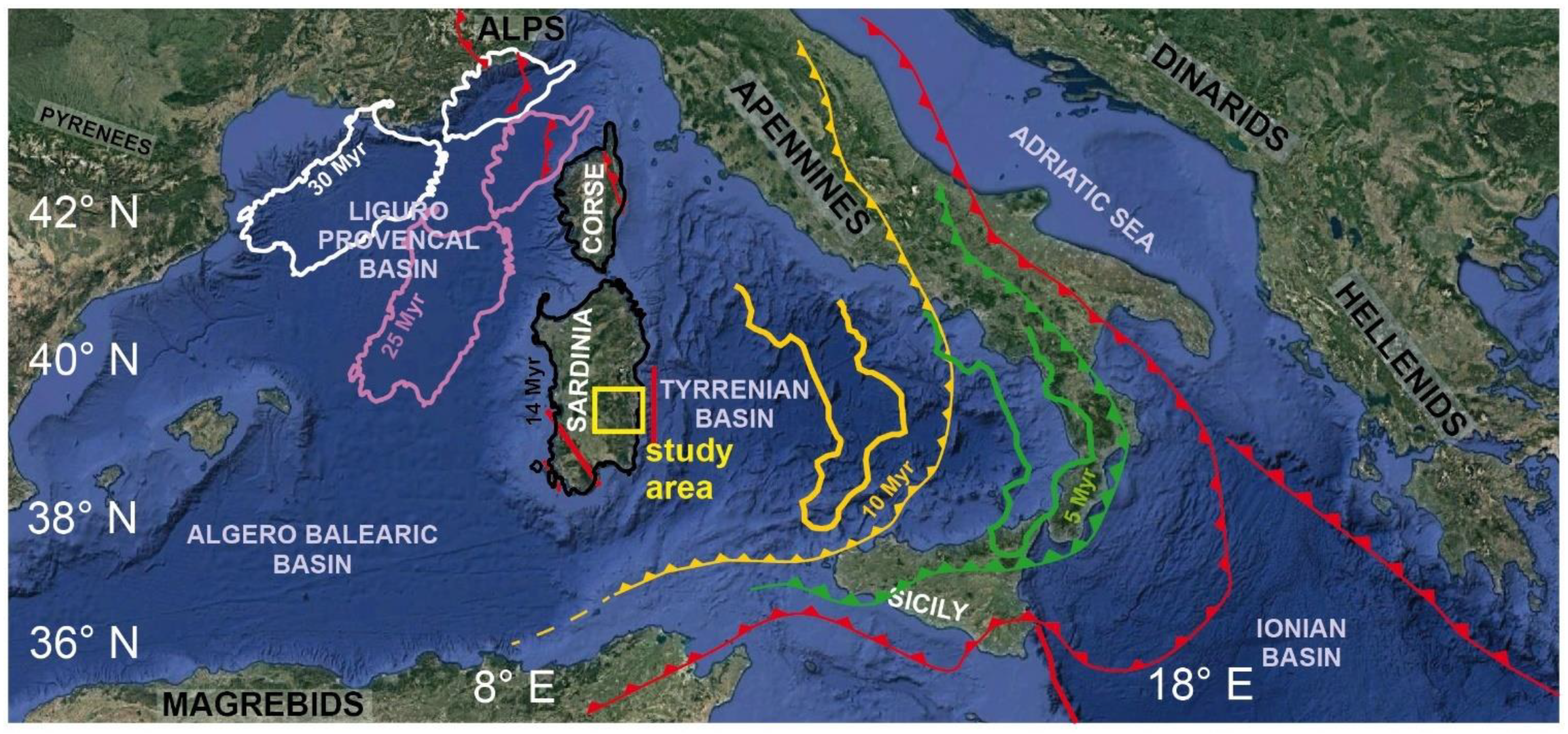
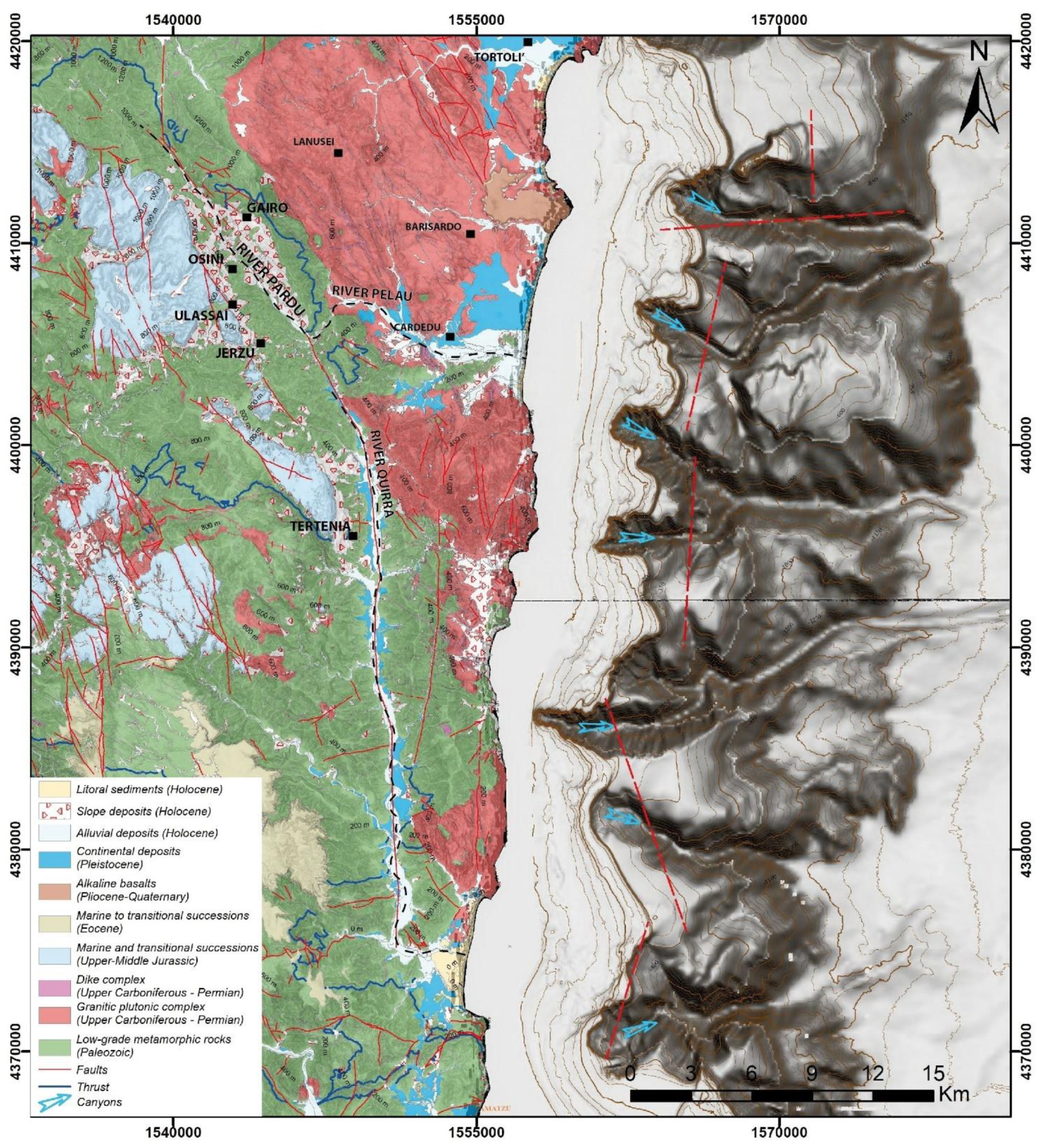
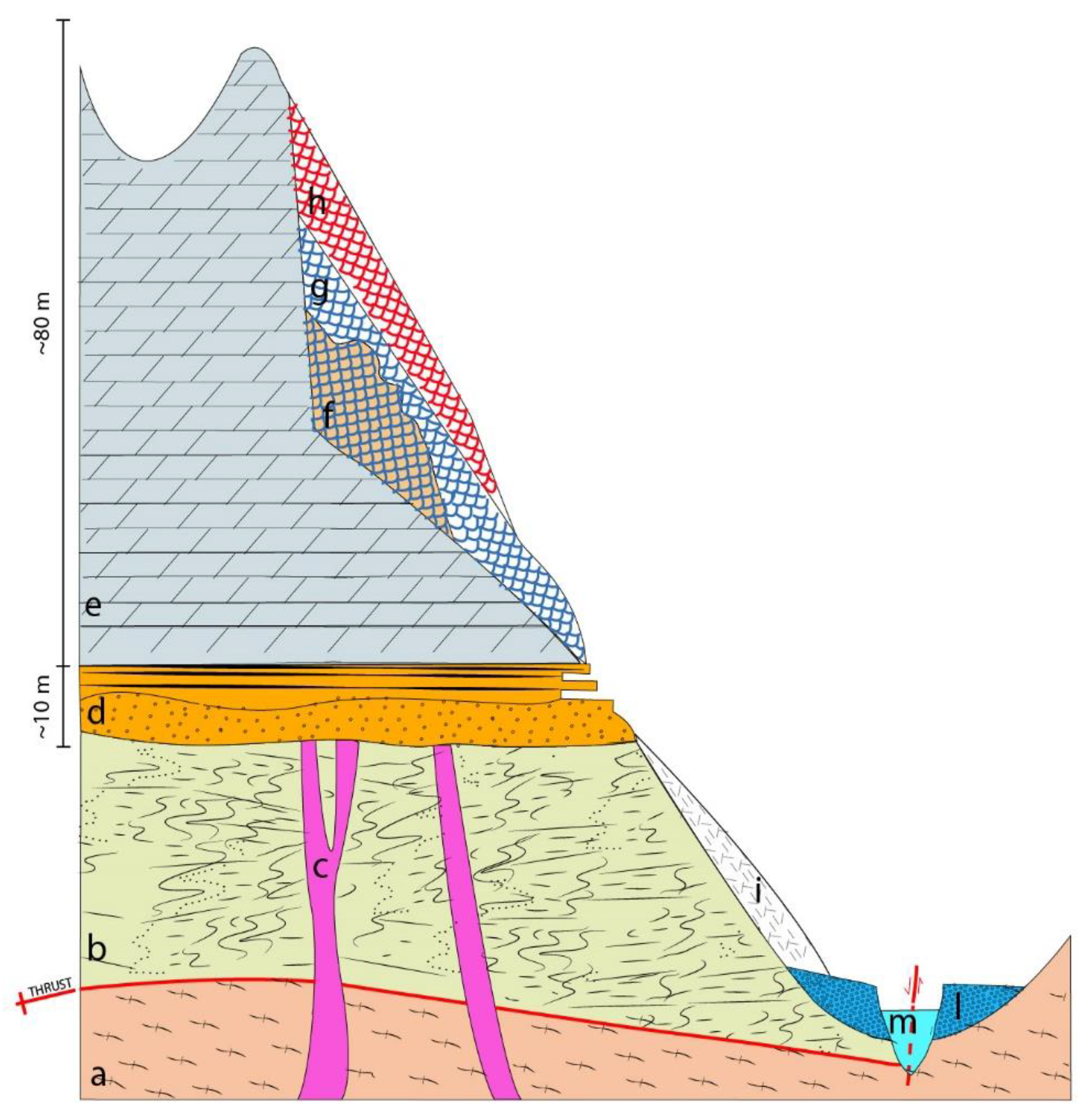
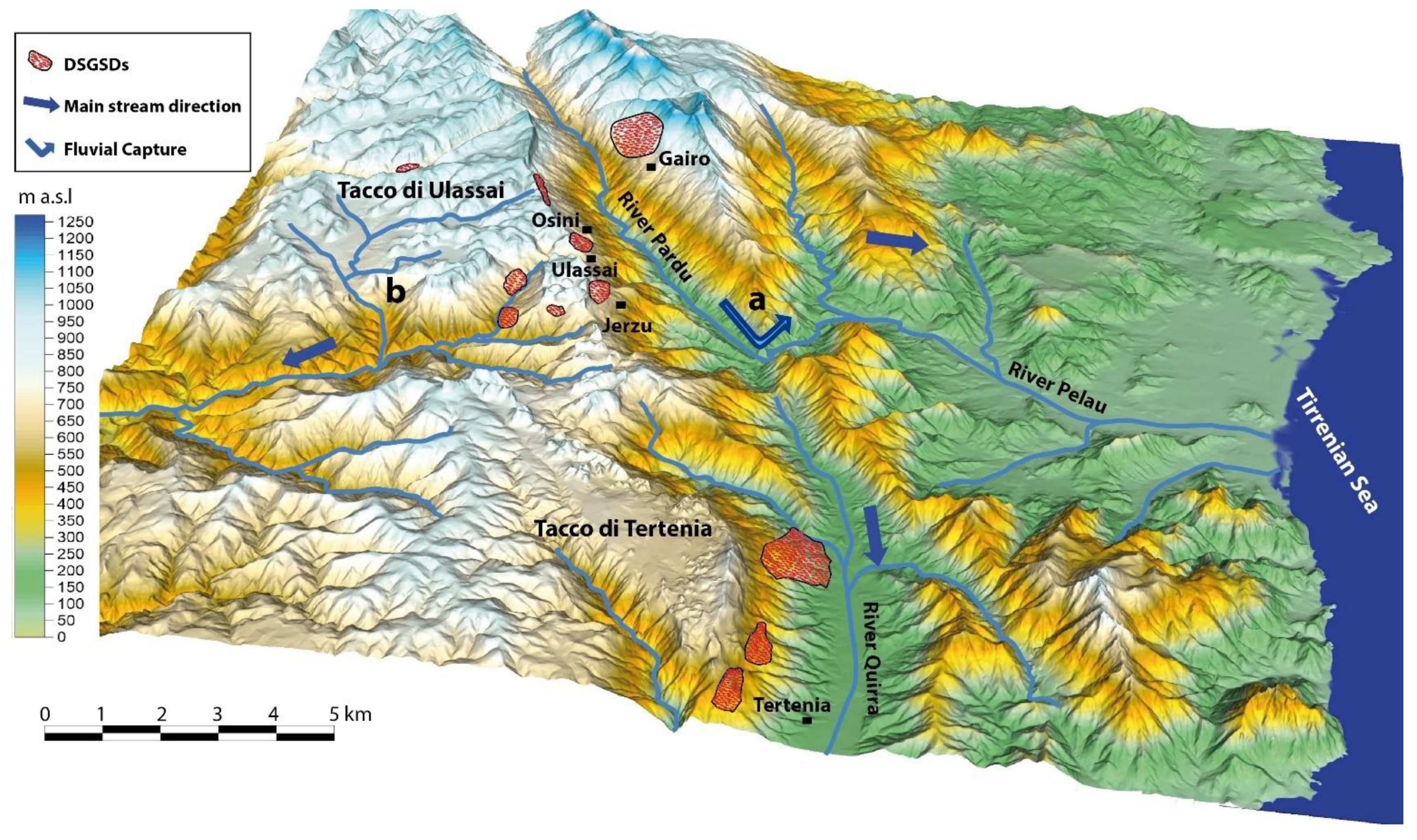


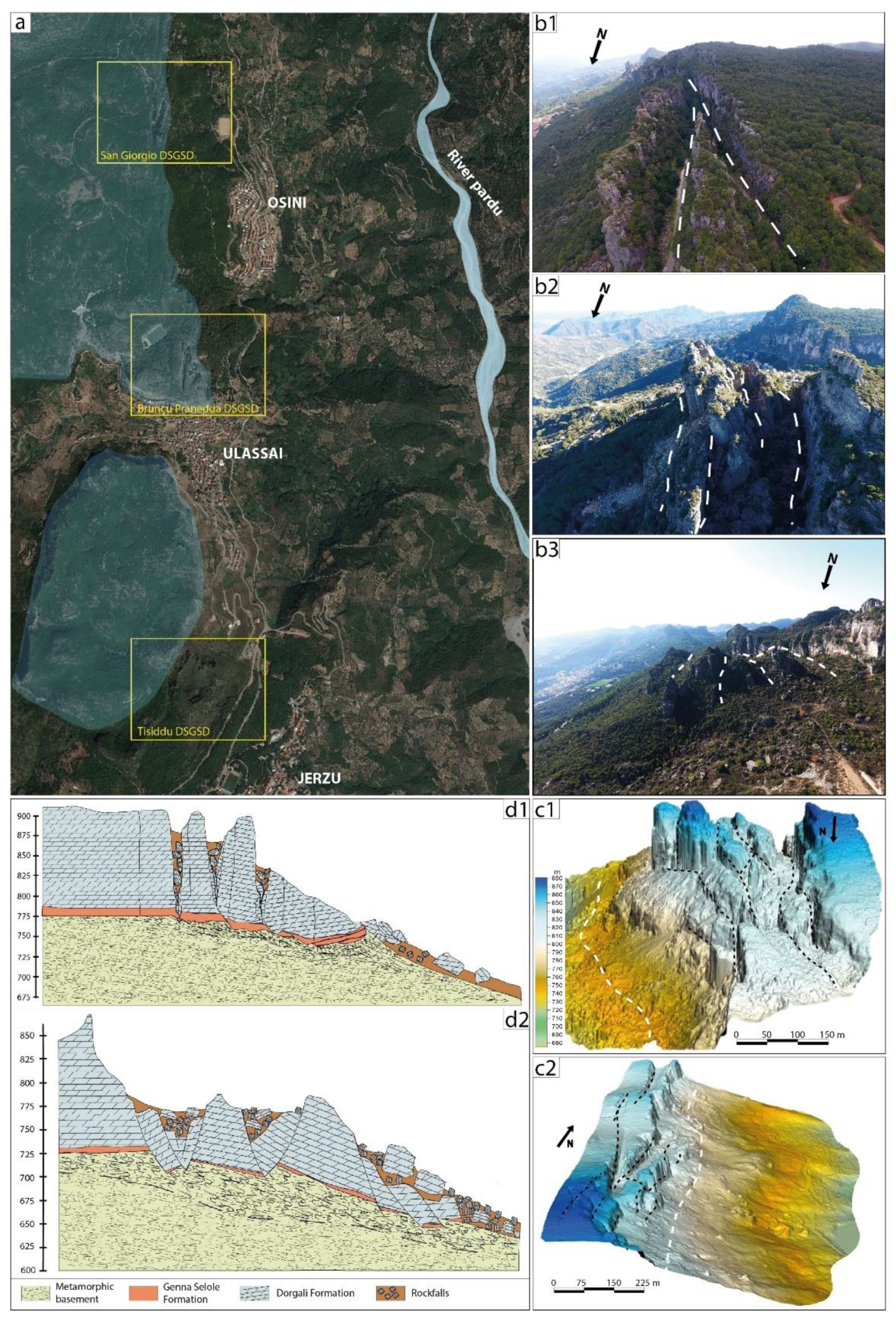
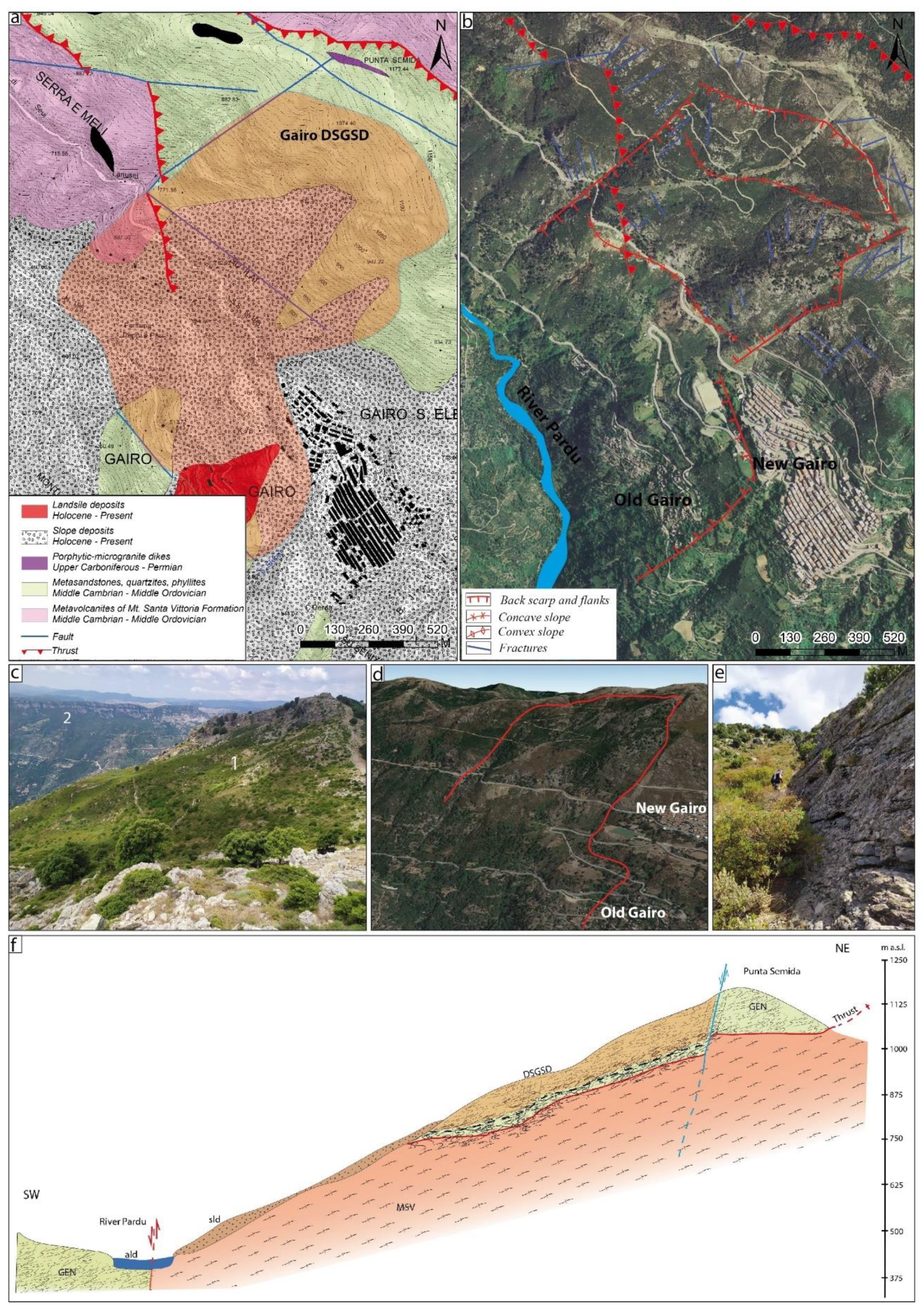
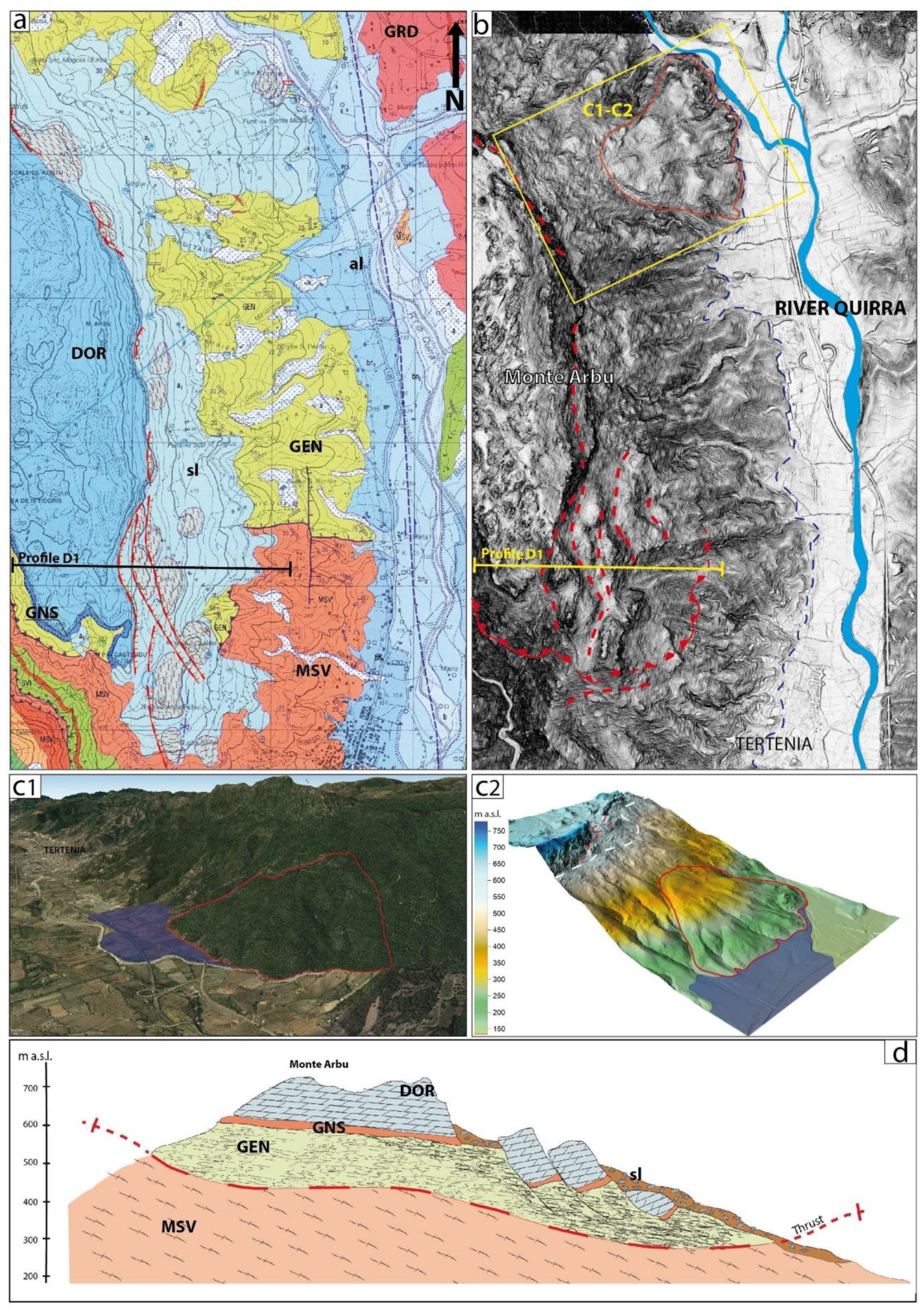
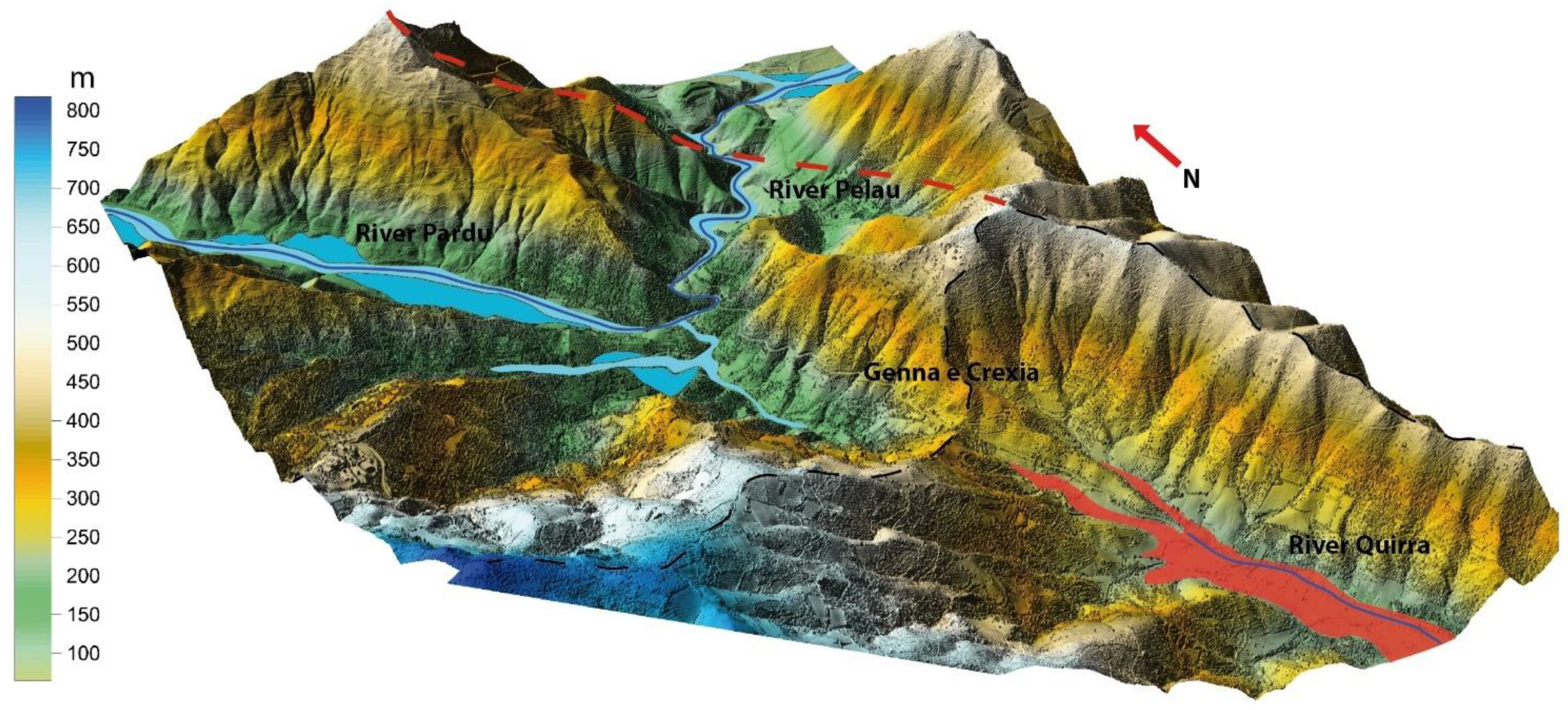
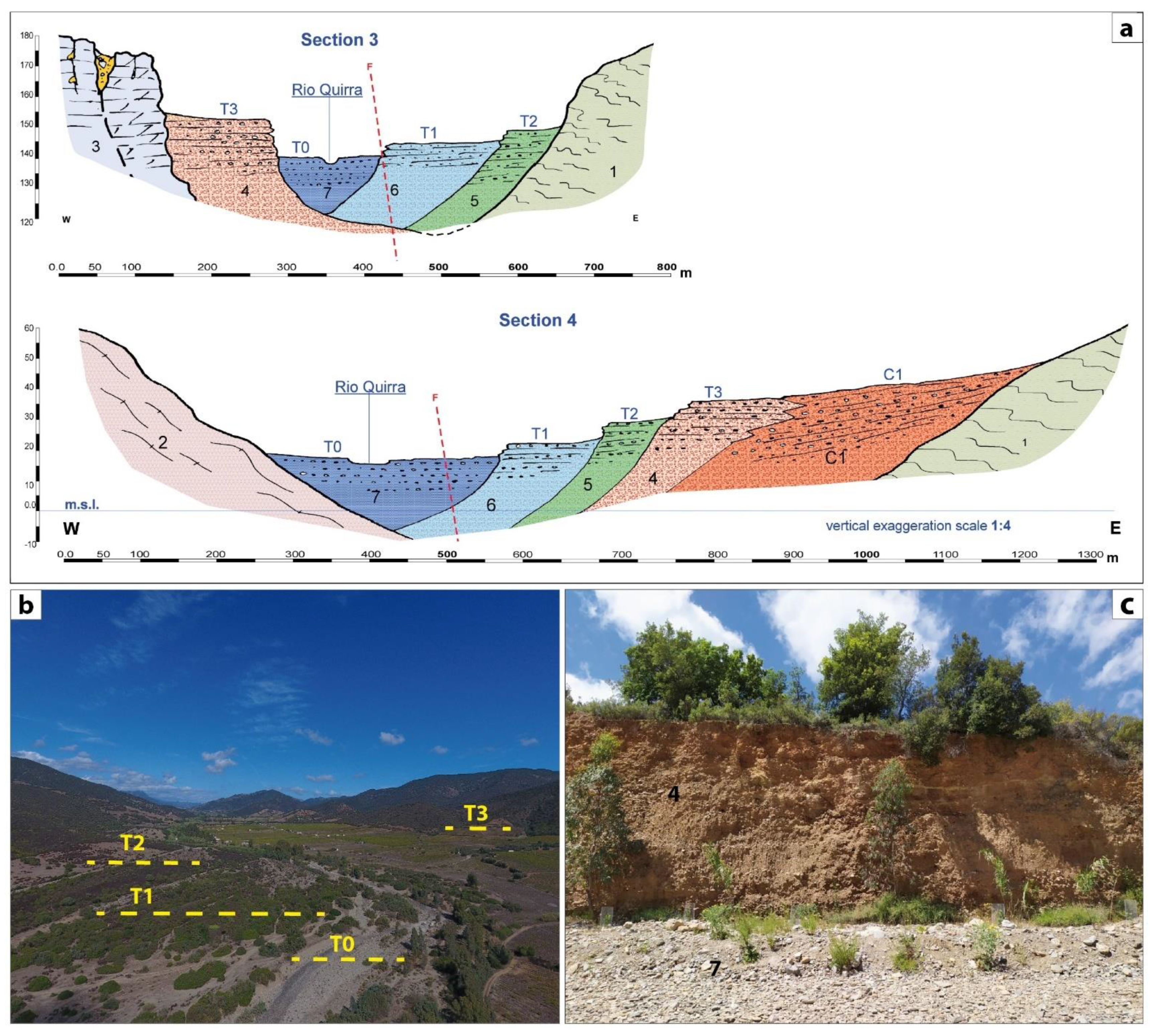

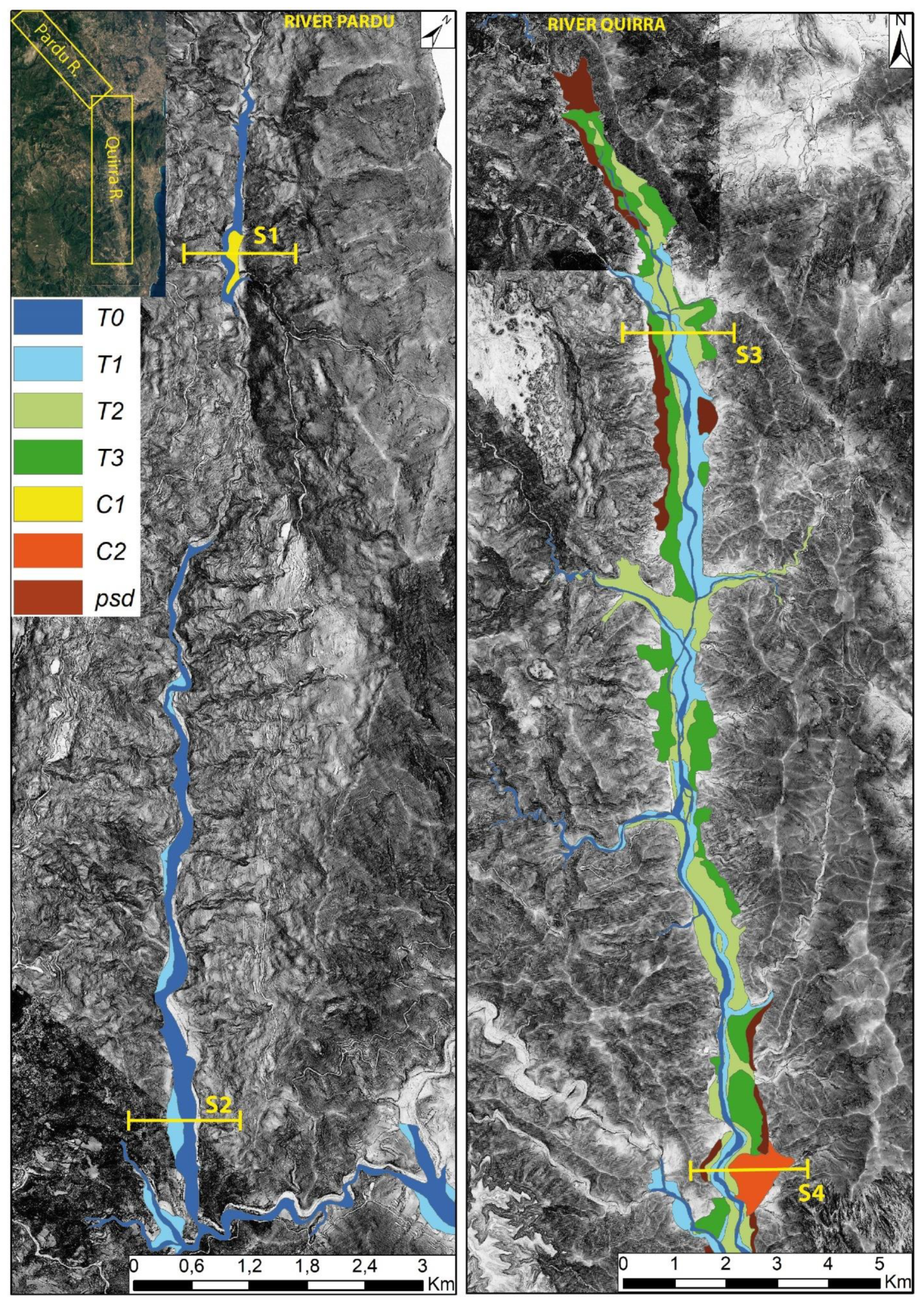

| Area | Satellite | Acquisition Geometry | Acquisition Interval | TrackAngle | Inc Angle |
|---|---|---|---|---|---|
| Ulassai | Sentinel 1 | Ascending | Oct 2014–Feb 2020 | −9.6 | 42.4 |
| Osini | Sentinel 1 | Ascending | Oct 2014–Feb 2020 | −9.6 | 42.4 |
| San Giorgio | Sentinel 1 | Ascending | Oct 2014–Feb 2020 | −9.6 | 42.4 |
| Gairo | Sentinel 1 ERS | Descending | Oct 2014–Feb 2020May 1992–Dec 2000 | −169.6 - - - - - | 36.3 - - - - - |
| Location | Landslide | Geology | Landslide Kinematic | Displacement Speed mm/y | Displacement Trend | Area Km2 |
|---|---|---|---|---|---|---|
| North Ulassai | Bruncu Pranedda Lateral spread | Dolomitic limestone set on altered and fractured phillites | Lateral spread top slope; sackung middle slope | 6–10 mm/y | Seasonal | 0.2 |
| South Ulassai | Monte Tisiddu Sackung | Dolomitic limestone set on altered and fractured phillites | Sackung | No movement | ------ | 0.2 |
| North Osini (San Giorgio) | San Giorgio Lateral spread | Dolomitic limestone set on altered and fractured phillites | Lateral spread | No movement | ------ | 0.03 |
| North Osini | San Giorgio paleo-rock avalanche | Megablock rock avalanche deposits set on paleo-rockfalls | Sliding | 6–>10 | Linear | ≈0.1 |
| Osini | Osini Landslide | Cemented paleo-rockfalls set on phillites | Sliding | 4–8 | Seasonal | ≈0.3 |
| Gairo | Gairo DGSD | Phillites on metavolcanites. Slope involved in Hercinical thrust | Sackung | 6–20 | Linear | 1.2 |
| South Tertenia | Tertenia DGSD | Dolomitic limestone set on altered and fractured phillites. Slope involved in Hercinical thrust | Sackung | No movement | ------ | 1.5 |
| North Tertenia | Paleo-DGSD | Dolomitic limestone set on altered and fractured phillites | Sackung | No movement Fossilized by Pleistocenic alluvium | ------ | 1.5 |
| Deposits | Characteristic | Elevation from Talweg | Distribution |
|---|---|---|---|
| T0 | Pebbles and clastosustained gravels with a scarce sandy matrix | 0 | Actual embrided riverbed |
| T1 | Heterometric and polygenic pebbles with a scarce dark matrix | 0.20/0.30–1.5 | Pardu-Quirra |
| T2 | The matrix is decidedly prevalent in the coarse fraction | 2–5/6 | Quirra |
| T3 | Non-constant matrix–skeleton relationship. Reddish matrix (Fe oxides) | 6/7–10 | Quirra |
| Paleo-conoid C1 | Clastosustained pebbles up to 40–50 cm in size. Scarce matrix | 30 | Pardu |
| Paleo-conoid C2 | Reddish pebbles and gravels in sandy, silty, reddish matrix | 15 | Quirra |
| Paleo-slope deposits | 20–40 | Quirra |
Publisher’s Note: MDPI stays neutral with regard to jurisdictional claims in published maps and institutional affiliations. |
© 2021 by the authors. Licensee MDPI, Basel, Switzerland. This article is an open access article distributed under the terms and conditions of the Creative Commons Attribution (CC BY) license (https://creativecommons.org/licenses/by/4.0/).
Share and Cite
Demurtas, V.; Orrù, P.E.; Deiana, G. Evolution of Deep-Seated Gravitational Slope Deformations in Relation with Uplift and Fluvial Capture Processes in Central Eastern Sardinia (Italy). Land 2021, 10, 1193. https://doi.org/10.3390/land10111193
Demurtas V, Orrù PE, Deiana G. Evolution of Deep-Seated Gravitational Slope Deformations in Relation with Uplift and Fluvial Capture Processes in Central Eastern Sardinia (Italy). Land. 2021; 10(11):1193. https://doi.org/10.3390/land10111193
Chicago/Turabian StyleDemurtas, Valentino, Paolo Emanuele Orrù, and Giacomo Deiana. 2021. "Evolution of Deep-Seated Gravitational Slope Deformations in Relation with Uplift and Fluvial Capture Processes in Central Eastern Sardinia (Italy)" Land 10, no. 11: 1193. https://doi.org/10.3390/land10111193
APA StyleDemurtas, V., Orrù, P. E., & Deiana, G. (2021). Evolution of Deep-Seated Gravitational Slope Deformations in Relation with Uplift and Fluvial Capture Processes in Central Eastern Sardinia (Italy). Land, 10(11), 1193. https://doi.org/10.3390/land10111193







